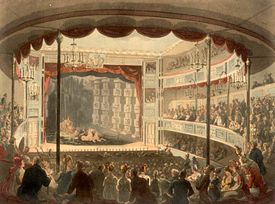
Aqua drama
Encyclopedia

Naumachia
The naumachia in the Ancient Roman world referred to both the re-enactment of naval battles and the basin in which this took place....
, and the custom was resurrected at various times during the Middle Ages
Middle Ages
The Middle Ages is a periodization of European history from the 5th century to the 15th century. The Middle Ages follows the fall of the Western Roman Empire in 476 and precedes the Early Modern Era. It is the middle period of a three-period division of Western history: Classic, Medieval and Modern...
.
19th century performances
During Charles DibdinCharles Dibdin
Charles Dibdin was a British musician, dramatist, novelist, actor and songwriter. The son of a parish clerk, he was born in Southampton on or before 4 March 1745, and was the youngest of a family of 18....
’s management, the Aquatic Theatre, as Great Britain's Sadler's Wells Theatre
Sadler's Wells Theatre
Sadler's Wells Theatre is a performing arts venue located in Rosebery Avenue, Clerkenwell in the London Borough of Islington. The present day theatre is the sixth on the site since 1683. It consists of two performance spaces: a 1,500 seat main auditorium and the Lilian Baylis Studio, with extensive...
was then known, specialized in marine spectacles and nautical dramas. Its proximity to the New River
New River (England)
The New River is an artificial waterway in England, opened in 1613 to supply London with fresh drinking water taken from the River Lea and from Amwell Springs , and other springs and wells along its course....
meant easy access to the necessary water. The Siege of Gibralter, mounted in 1804, deployed 117 model ships created by the Woolwich Dockyard
Woolwich Dockyard
Woolwich Dockyard was an English naval dockyard founded by King Henry VIII in 1512 to build his flagship Henri Grâce à Dieu , the largest ship of its day....
shipwrights which were capable of firing their guns. For the parts of drowning Spanish sailors, Dibdin cast children who were seen struggling in the waves.
In 1823 Sadler’s Wells presented the aqua drama entitled The Island or Christian and His Comrades which dramatized the main events of the Mutiny on board HMS Bounty
Mutiny on the Bounty
The mutiny on the Bounty was a mutiny that occurred aboard the British Royal Navy ship HMS Bounty on 28 April 1789, and has been commemorated by several books, films, and popular songs, many of which take considerable liberties with the facts. The mutiny was led by Fletcher Christian against the...
. In order to alleviate a twenty minute delay between a dry land scene and an aquatic scene, the stage was made to ascend to near the roof of the theatre, in full view of the audience.
New York City
New York City
New York is the most populous city in the United States and the center of the New York Metropolitan Area, one of the most populous metropolitan areas in the world. New York exerts a significant impact upon global commerce, finance, media, art, fashion, research, technology, education, and...
's Lafayette Circus
Lafayette Circus (Theatre)
Lafayette Circus Theatre emerged in Manhattan in 1825 as an equestrian circus arena; in 1826–1827 it was rebuilt into a conventional theatre hall with an orchestra pit and advanced rigging. It boasted equipment for both equestrian and aquatic drama...
(1826-1829) boasted equipment for both equestrian, or "Hippodrama"
Hippodrama
Hippodrama, or horse drama, is a genre of theatrical show blending circus horsemanship display with popular melodrama theatre. Evolving from earlier equestrian circus, pioneered by Philip Astley in the 1760s,, it relied on drama plays written specifically for the genre; trained horses were...
, and aquatic dramas.
On July 4, 1840, The Bowery Theatre
Bowery Theatre
The Bowery Theatre was a playhouse in the Bowery neighborhood of New York City. Although it was founded by rich families to compete with the upscale Park Theatre, the Bowery saw its most successful period under the populist, pro-American management of Thomas Hamblin in the 1830s and 1840s...
in New York City
New York City
New York is the most populous city in the United States and the center of the New York Metropolitan Area, one of the most populous metropolitan areas in the world. New York exerts a significant impact upon global commerce, finance, media, art, fashion, research, technology, education, and...
produced The Pirates Signal. An immense stage was entirely covered by water upon which a full-rigged ship maneuvered. The scene took place upon the decks of the ship itself.

